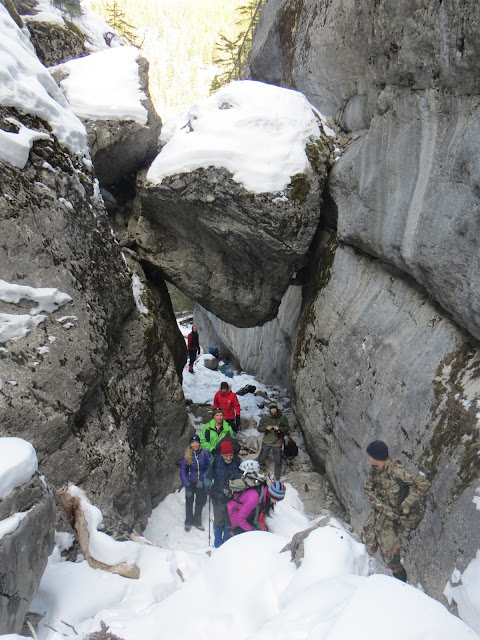 |
| The choke stone in McGillivray Canyon |
Recently, I found an even better canyon: McGillivray Canyon. It had about a kilometer of tighter, curvier walls with chains and a ladder bolted into the rock to help climb up and over obstacles and steps. Near the end a giant choke stone was suspended above the canyon floor like something out of an Indiana Jones movie. At 4 km round trip, it was a fun little hike for adults, but it would be an extreme adventure for kids.
See how the actual kids hike to McGillivray Canyon went
Click here for more kids hikes in Banff, Kananaskis, Kootenay and other areas of the Canadian Rockies.
 |
| One of the cables over a frozen pond |
One question I get asked a lot is how I pick my kids hikes. Even experienced hikers ask. Especially experienced hikers. They want to take their kids beyond the usual interpretive trails and standard easy hikes, but they're worried about taking them on a trail too that's too hard or too far. My answer is simple: the 3 Ds of picking a kid friendly trail. Discovery, due diligence, decision.
 |
| The Khumbu Icefalls for kids |
1. Discovery
I call this the "Aha!" moment. It's when I realize that a trail would be great for kids. In the case of McGillivray Canyon, it was the moment we entered the canyon and I saw the high narrow walls. Then I saw the chains and had a double Aha. In other cases, it's coming across a boulder field for the kids to climb on (see my post on hiking Little Lougheed with kids) or fossils for them to hunt (see my post on hiking Burns Ridge with kids). |
| Chains to help climb a short step |
2. Due Diligence
When I get back home, I start the due diligence process to make sure I haven't missed anything that would rule the trail out or that I should be aware of before taking kids on it. This includes assessing hazards on the route. If possible I talk to other people who have hiked the trail. Other sources of beta (information) include websites with trip reports, Google Images for photos, and guide books.In the case of McGillivray Canyon, one of the hazards were the many frozen pools in the canyon bottom. They were small and had logs across them, but in January they were frozen and we could walk right over them. There were also cables strung over the logs to hold onto, but some might be too high for kids to reach. Google Images confirmed that the logs did indeed cross standing pools of water in summer, but not how deep they were. Could the kids cross the pools on the logs without excessive risk of going for a dip? If they did go for a dip, what would be the consequences? Could a parent walk through the ponds to help kids out if necessary?
Then there was the source of the water in the pools. How much water flowed in the canyon once the ice melted?
 |
| The highest chained section. Tricky with ice, kids should be able to climb it dry. |
3. Decision
The ice on a couple frozen ponds had broken, revealing gravel two or three inches below. Talking with people in the Calgary Outdoor Recreation Association (CORA) who'd done the canyon in summer and fall, it sounded like most of the pools were ankle deep. Deep enough to drown in, but not so deep a parent couldn't quickly scoop a kid up. Trip reports on the web suggested that the water was no more than a trickle after the spring run off was finished.The decision: I'll schedule a McGillivray Canyon kids hike this summer, probably in late July or August--well after spring run off. Stay tuned for the trip report.
Post Script: When I post this kids hike on CORA's website, I'll include a description of the chains, the logs and the possibility of the trickle turning into a torrent if an expected storm hits. Letting other parents know about the hazards is not only a courtesy, it's a responsibility. I appreciate the trust parents put in my judgement when they come on one of my kids hikes, but I can only decide what risks are acceptable to expose my own kids to. It's up to other parents to make the same informed decisions for their own kids.
 |
| The boulders at the end. |

Excellent post! Thanks for the great share. Very interesting .
ReplyDelete